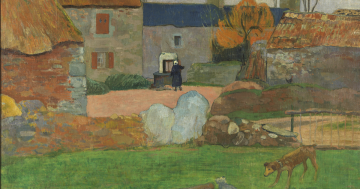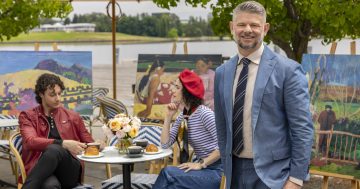
The artworks in question: The group consists of Bodhisattva Avalokiteshvara Padmapani (main figure), Bodhisattva Vajrapani (left) and Bodhisattva Avalokiteshvara Padmapani (right). Photo: NGA.
The National Gallery of Australia is investigating the provenance of 9th-10th century Khmer artworks in its collection that may have been looted.
In a recent report from the International Consortium of Investigative Journalists, the NGA was named along with other prominent institutions including the Met in New York and the British Museum in London, as holding works believed to have been linked to the notorious art looter, Englishman Douglas Latchford.
It says the works, Bodhisattva Avalokiteshvara Padmapani with attendants, was acquired with the assistance of Sally and Geoffrey White in 2011.
The group consists of three statues – the main figure Bodhisattva Avalokiteshvara Padmapani, Bodhisattva Vajrapani (left) and Bodhisattva Avalokiteshvara Padmapani (right) – from the Cham kingdom, which spanned parts of modern Vietnam as well as Cambodia.
The NGA is determining which country they should be returned to.
The current provenance chain started with a London art dealer in the early 1990s who sold it to a private collector there before the NGA acquired it.
But the NGA said these works were the subject of a significant live investigation that was nearing its conclusion.
“To release specific details at this time would compromise that investigation,” a spokesperson said. “We look forward to discussing it publicly soon.”
Last July, the NGA announced it would return 14 works of art from its Asian collection to the Indian Government.
The ICIJ report said the United States indicted Latchford in 2019, and it seemed then that hundreds of stolen items he had traded might be identified and returned, but the 88-year-old died before trial, leaving the whereabouts of the works a mystery.
The recent release of the Pandora Papers has revealed previously undisclosed records describing secret offshore companies and trusts that Latchford and his family controlled.
US investigators continue to pursue the return of items and the Cambodian Minister of Culture and Fine Arts, Phoeurng Sackona, says his country will never give up pursuing the return of its heritage.
“These objects are not just decorations, but have spirits and are considered as lives,” she told the ICIJ. “It is hard to quantify their loss to our temples and country — losing them was like losing the spirits of our ancestors.”
The financial records prompted an international media hunt for the stolen artworks and turned up a number in the institutions named in the ICIJ report.
Asked what will happen to the artworks if they are found to be stolen, the NGA spokesperson said the decision to return works of art was the culmination of years of research, due diligence and an evolving framework for decision-making that includes both legal principles and ethical considerations.
“The National Gallery has undertaken the development of a comprehensive Provenance and Due Diligence Policy and Provenance Decision-Making Framework,” the spokesperson said.
“We will follow the process as outlined in these documents, as per the precedent set in July when the Gallery returned 14 works of art to India.”
The spokesperson said the NGA had established an ongoing system of review for all works of art in the collection, including Aboriginal and Torres Strait Islander art, and would address any issues raised by this or any other research through the Provenance Decision-Making Framework.
“The National Gallery welcomes any information that assists us to better understand the prior collecting history or origins of all works of art in the collection,” the spokesperson said.
Over the past seven years, the NGA’s provenance research has led to the removal from the collection of 24 works.




















